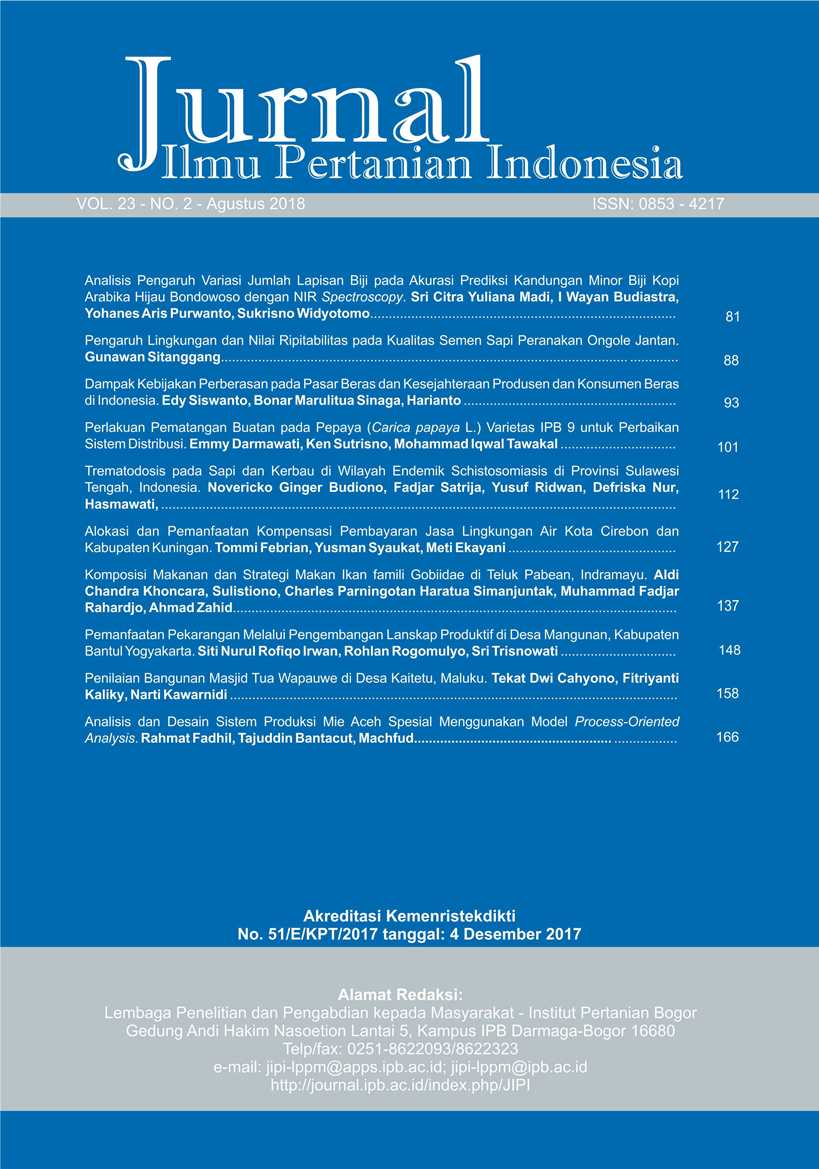Pemanfaatan Pekarangan Melalui Pengembangan Lanskap Produktif di Desa Mangunan, Kabupaten Bantul Yogyakarta
Abstract
Utilization of land around a house as a pakarangan supports the quality and biodiversity of ecosystems. Utilization of pekarangan will develop a productive landscape in order to support food production for household and social interaction facility with neighbors. Mangunan Village has a category of marginal land because of the character of a dry land, rocky, far from water sources, and hilly topography. Therefore this village needs plants that can be adaptable for the environmental characteristics. The research aimed to identify the utilization of pekarangan, to find out the opinions of the people through the utilization of pekarangan and to reveal the linkage of plant functions in developing a productive landscape of pekarangan. Data were collected by purposive sampling with samples of 180 households spreading over six clusters of dusun in Mangunan Village. Variables of research were land area, species and quantity of plants, and people response in developing the productive landscape. Utilization of pekarangan in a wide variety of planting covering planting fruit crops (31%), herbal plants (20%), aesthetics plants (15%), and vegetables (15%). Mangunan Village has diversity index of pekarangan on medium rate (H’ 2.65) and evenness of species on stable position (E 0.32). Therefore, Mangunan Village requires more plants and species to keep a better ecosystem. Community in Mangunan Village was very enthusiastic in the utilization of pekarangan for provisioning food (59%). People require assistance to implement pekarangan functions because they have not enough knowledge on pekarangan plan. The plant functions had high linkage and low linkage in developing productive landscape of pekarangan.
Downloads
References
Arifin HS, Munandar A, Schultin KG, Kaswanto RL. 2012. The Role And Impacts Of Small-Scale, Homestead Agro-Forestry Systems (”Pekarangan”) On Household Prosperity: An Analysis Of Agro-Ecological Zones Of Java, Indonesia. International Journal of Agri Science. 2(10): 896-914.
Calvet-Mir L, Gomez-Baggethun E, Reyes-Garcia V. 2012. Beyond Food Production: Ecosystem Services Provided By Home Gardens. A Case Study In Vall Fosca, Catalan Pyrenees, Northeastern Spain. Ecological Economics. 74 : 153-160. https://doi.org/10.1016/j.ecolecon.2011.12.011
Carpenter PL, Theodore DW. 1990. Plants in the Landscape. Second edition. USA (US):Waveland Press Inc.
Feriatin. 2017. Keanekaragaman Tanaman Pekarangan Dan Pemanfatannya Untuk Mendukung Ketahanan Pangan Kecamatan Wakorumba Selatan. Jurnal Ilmu Pertanian Indonesia. 22(2): 99-107. https://doi.org/10.18343/jipi.22.2.99
Gbedomon RC, Assogbadjo AE, Salako VK, Fandohan AB, Kakai RG. 2016. Exploring The Spatial Configurations Of Home Gardens In Benin. Scientia Horticulturae. 213: 13-23. https://doi.org/10.1016/j.scienta.2016.10.020
Irwan SNR, Sarwadi A. 2017. Productive Landscape In Home Garden Development In Yogyakarta City. Prosiding in 2nd International Symposium for Sustainable Landscape Development. IOP Conf. Series: Earth and Environmental Science 91 (2017) 012006.
Irwan SNR, Taryono, Susilo, Erlina A, Trisnowati S, Rogomulyo R, Respatie DW. 2014. Perencanaan Kebun Buah Tropika di Kawasan Pusat Inovasi Agroteknologi (Piat) Ugm Mangunan Girirejo Kabupaten Bantul Yogyakarta. Prosiding Seminar Nasional Buah Tropika Nusantara II; 563-570. Bukittinggi Sumatera Barat, 23-25 September 2014.
Krebs CJ. 1989. Ecological Methodology. Second Edition. Canada (CO): University of British Columbia. An imprint of Addison Wesley Longman, Inc.
Mukarlina, Linda R, Nurlaila N. 2014. Keanekaragaman Jenis Tanaman Pekarangan Di Desa Pahauman Kecamatan Sengah Temila Kabupaten Landak, Kalimantan Barat. Jurnal Saintifika. 16(1): 51-62.
Odum, EP. 1996. Dasar-dasar Ekologi. Penerjemah Tjahjono Samingan, edisi ketiga. Yogyakarta (ID):Gadjah Mada University Press.
Pemerintah Desa Mangunan. 2014. Profil Wilayah Desa. http://mangunan.bantulkab.go.id/index.php/first/artikel/94
Sagrim M, Sumule AI, Lyai DA, Baransano M. 2017. Potensi Unggulan Komoditas Pertanian pada Daerah Dataran Tinggi Kabupaten Pegunungan Arfak, Papua Barat. Jurnal Ilmu Pertanian Indonesia. 22(3): 141-146. https://doi.org/10.18343/jipi.22.3.141
van Heezik YM, Dickinsonb KJM, Freeman C, Porterc S, Wingb J, Barratt, BIP. 2016. To What Extent Does Vegetation Composition and Structure Influence Beetle Communities and Species Richness in Private Gardens in New Zealand. Landscape and Urban Planning. 151 : 79–88. https://doi.org/10.1016/j.landurbplan.2016.02.013
van Heezik YM, Dickinsonb KJM, Freeman C, Porterc S. 2014. Native and Exotic Woody Vegetation Communities in Domestic Gardens in Relation To Social and Environmental Factors. Ecology and Society. 19(4): 17. https://doi.org/10.5751/ES-06978-190417
Viljoen A, Bohn K, Howe J, 2005. Continous Productive Urban Landscapes (CPULs). Oxford (EN): Burlington: Architectural Prees.
This journal is published under the terms of the Creative Commons Attribution-NonCommercial 4.0 International License. Authors who publish with this journal agree to the following terms: Authors retain copyright and grant the journal right of first publication with the work simultaneously licensed under a Creative Commons Attribution-NonCommercial 4.0 International License. Attribution — You must give appropriate credit, provide a link to the license, and indicate if changes were made. You may do so in any reasonable manner, but not in any way that suggests the licensor endorses you or your use. NonCommercial — You may not use the material for commercial purposes.























